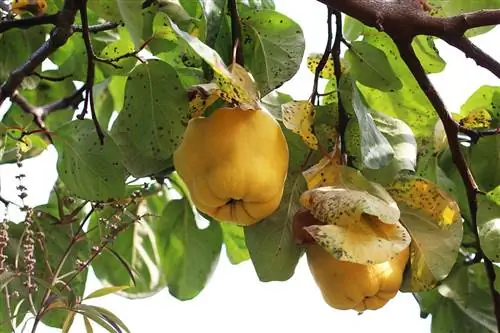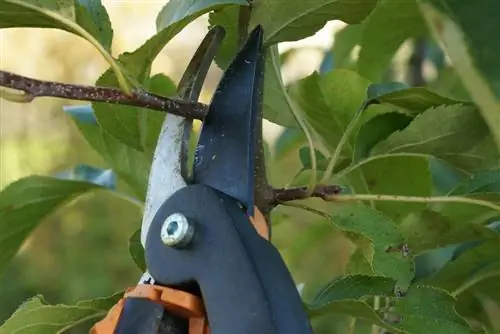- Author admin [email protected].
- Public 2023-12-17 03:39.
- Last modified 2025-06-01 06:48.
You can usually cut the rubber tree (Ficus elastica) at any time. By pruning you can keep it at a certain size or change its growth habit by encouraging the formation of side shoots. Despite everything, you should plan enough space for this plant. The special adornment of this evergreen houseplant is its large, thick, strong green leaves. It prefers bright locations, but also copes well with less light. It can also have a positive effect on the indoor climate.
The best time to cut
This majestic plant can reach a considerable size. Due to one-sided light incidence, it can sometimes grow a little crooked or become bare underneath in an unfavorable location. All of these are good reasons to cut it back accordingly. A corresponding pruning can actually be done at any time. However, the winter months and the evening hours are particularly recommended, because then the plant is dormant and the sap flow is not as strong. New shoots will appear in the following spring.
Tip:
Tip: The clippings resulting from pruning can be used to obtain cuttings to propagate this houseplant.
The actual cut
If you want the rubber tree to grow bushier or limit its height, you can shorten the entire crown. If, on the other hand, upright growth is desired, the side shoots can also be removed. Before you make the first cut, you should look at the rubber tree carefully. The main thing is the sleeping eyes, which are located at certain distances on the trunk. These are dormant buds that can be recognized by small bulges.
Ideally, you cut the trunk or crown at the desired height, always a few centimeters above a sleeping eye. If the rubber tree already has branches, branches above a sleeping eye can also be shortened if you want them to branch out further. The plant then forms new shoots from the remaining eyes, although not from all of them. If you want to promote upright growth, cut off the side shoots either directly on the trunk or above a sleeping eye.
Tip:
When the plant is cut, a milky sap emerges at the interfaces, which can trigger severe allergic reactions in people who are allergic to latex. It is therefore advisable to wear gloves when carrying out any cutting work. Allergy sufferers should avoid keeping this plant if necessary.
The right tool
In order not to injure the plant too much when cutting and to avoid bruising, it is important to use suitable tools. If necessary, this should be disinfected beforehand, for example with alcohol, to prevent the transmission of diseases. The trunk and side shoots can be shortened with sharp secateurs. The sharper the tool, the less likely the rubber tree will be injured. A sharp knife is usually sufficient to shorten or remove the side shoots. Regardless of the type or quality of the tools used, a milky liquid comes out after every cut and the plant bleeds. As a result, it is important to treat the cuts appropriately after cutting to prevent individual parts of the plant from bleeding and drying out.
Wound Care
- Special plastic plugs and wax are available in stores.
- First, sprinkle the cut surfaces with warm water.
- Then you seal it with the soft wax.
- Charcoal or ash is also said to be very suitable for disinfecting wounds.
- Part of the trunk can dry out and die despite the wound closure.
- As long as this part is above the sleeping eye, this is not a problem.
- The new growth will still occur.
- The dead part should then be removed along with a he althy piece of trunk.
- This cut is also made over a sleeping eye.
Use clippings as cuttings
The clippings resulting from cutting the rubber tree can be easily used for propagation. The respective cutting should be 7-10 cm long and the lowest leaves should be removed. At least 1 leaf and 1 eye should remain on the cutting. After the cutting has dried a little, treat the cut surface with charcoal ash and then insert about half of it into a suitable growing substrate. The substrate is slightly moistened and a translucent foil bag is placed over the cutting or pot. The film should be removed regularly and the whole thing should be ventilated for a short time to avoid mold and rot. After about 8-12 weeks in a bright and warm place, enough roots will have formed so that the foil can be removed and the cutting can be placed in a small pot. If it is well rooted, it can be repotted into a larger one.
Tip:
In addition to propagating cuttings, the rubber tree can also be propagated by removing moss or sowing. Sowing is a little more difficult and time-consuming and doesn't always work.
What else needs to be taken into account when caring for it
Even if the rubber tree is very undemanding, care cannot be completely avoided. So he wants to be in a bright and warm place without drafts. It feels most comfortable at temperatures between 18 and 25 °C. In summer, water should be abundant without causing waterlogging. Excess water that is in the saucer or planter should always be removed immediately. There is significantly less watering during the winter months. During the growth phase, a green plant fertilizer can be administered once a month. In winter, fertilizer is completely avoided. Dust keeps accumulating on the large leaves of the rubber tree. This should also be removed regularly with a damp cloth for visual reasons.
If the air in the room is dry and too warm, pest infestation can occur, for example from spider mites, mealybugs, mealybugs or thrips. To prevent this as much as possible, it is helpful to spray the rubber tree with water every now and then, ideally with lime-free. If, despite everything, an infestation occurs, it should be treated as early as possible with appropriate means. Especially in winter, the plants must be checked again and again for possible infestation and, if an infestation is present, affected plants must be immediately isolated from he althy ones. This is the only way to prevent spread.
From time to time the rubber tree needs to be repotted into a larger container and fresh soil, be it because the pot is too rooted or the roots are already growing out of the bottom of the pot. The new planter should be a maximum of 5-10 cm larger than the old one. Good drainage is important. Carefully remove the plant from the pot and remove the old soil as well as rotten and dried root parts. The rubber tree is then planted in fresh substrate.
Tip:
Due to their better stability, plant pots made of clay are more suitable than plastic or ceramic pots.
Conclusion of the editors
Rubber trees can reach a maximum height of 5 m when kept indoors. This means that they require a relatively large amount of space. In order to curb the growth or change the growth form, this plant can be trimmed accordingly, which it tolerates very well. After the cut, you should definitely treat the wound, because not only can the plant bleed, pathogens can also penetrate through the cut and damage the rubber tree.
What you should know about rubber tree pruning in brief
Cutting rubber trees - when and how?
- The right time to prune is winter, as the rubber tree can then sprout again in spring.
- In general, a ficus is considered to be very easy to cut and if you pay attention to a few things, almost nothing can go wrong.
- If you shorten the tree, you promote bushier growth and the formation of new side shoots.
- It is optimal if the tree is cut off just above a spot with a “sleeping eye”.
- This is where new shoots can best develop.
- If you want to cut the entire trunk, you can use secateurs or a small saw.
- A normal household knife is sufficient to remove side shoots.
- When the rubber tree “bleeds,” a milky liquid comes out. This place should be closed!
- There is wax or plastic plug available specifically from specialist retailers.
Short if the rubber tree is bare below?
- You cut the trunk completely through, preferably close to an “eye” or the base of the leaf.
- Then place the upper part in a container with water and wait, wait, wait - this can take a few weeks until roots have formed again and therefore requires a lot of patience.
- Then the tree can be replanted in soil. By the way, you should wait until the roots are clearly visible and have become a little stronger.
The lower part is treated with wax at the interface or sometimes a brief torch with a lighter is recommended to close the wound - everything else is as usual and this will then form new side shoots after some time. Voilá - now you have two rubber trees and probably in a more beautiful shape!






